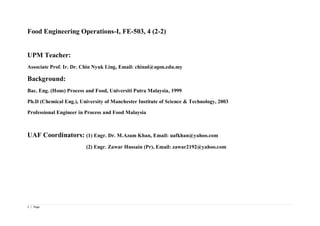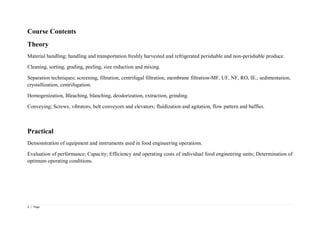Food engineering operations fe503 introduction handout
- 1. 1 | Page Food Engineering Operations-I, FE-503, 4 (2-2) UPM Teacher: Associate Prof. Ir. Dr. Chin Nyuk Ling, Email: [email protected] Background: Bac. Eng. (Hons) Process and Food, Universiti Putra Malaysia, 1999 Ph.D (Chemical Eng.), University of Manchester Institute of Science & Technology, 2003 Professional Engineer in Process and Food Malaysia UAF Coordinators: (1) Engr. Dr. M.Azam Khan, Email: [email protected] (2) Engr. Zawar Hussain (Pr), Email: [email protected]
- 2. 2 | Page Course Contents Theory Material handling; handling and transportation freshly harvested and refrigerated perishable and non-perishable produce. Cleaning, sorting, grading, peeling, size reduction and mixing. Separation techniques; screening, filtration, centrifugal filtration, membrane filtration-MF, UF, NF, RO, IE., sedimentation, crystallization, centrifugation. Homogenization, Bleaching, blanching, deodorization, extraction, grinding. Conveying; Screws, vibrators, belt conveyors and elevators; fluidization and agitation, flow pattern and baffles. Practical Demonstration of equipment and instruments used in food engineering operations. Evaluation of performance; Capacity; Efficiency and operating costs of individual food engineering units; Determination of optimum operating conditions.
- 3. 3 | Page References 1. Brennan, J.M. 2006. Food Processing Handbook. WILEY-VCH Verlag GmbH & Co. KGaA, Weinheim, Germany. 2. Ibarz, A and G.V. Barbosa-Cánovas. 2007. Unit operations in food engineering. CRC Press, Taylor & Francis Group, 6000 Broken Sound Parkway NW, Suite 300, Boca Raton, FL 33487-2742, USA. 3. Jun, S and J. M. Irudayaraj. 2009. Food Processing Operations Modeling (2nd ed.), Design and Analysis, CRC Press, Taylor & Francis Group, 6000 Broken Sound Parkway NW, Suite 300, Boca Raton, FL 33487-2742, USA. 4. Saravacos, G.D. and Z.B. Maroulis. 2011. Food Process Engineering Operations. CRC Press, Taylor & Francis Group, 6000 Broken Sound Parkway NW, Suite 300, Boca Raton, FL 33487-2742, USA. 5. Smith, P.G. 2011. Introduction to Food Process Engineering. Publisher Springer Berlin Heidelberg, Germany. Delivery On-line lecture Summary handouts Notes taking Examples and solutions Calculators
- 4. 4 | Page Time Table Week - Hours Date (Wednesday 2-5 pm) Content 1 - 3 hrs 9 October Introduction to course layout Syllibus and reference, Attendance, Grading Test and Exams 2 - 3 hrs 16 October Material handling; Cleaning, sorting. 3 - 3 hrs 23 October Grading, peeling, size reduction, mixing. 4 - 3 hrs 30 October Separation techniques; screening, filtration, centrifugal filtration, membrane filtration-MF 5 - 3 hrs 6 November Separation techniques; membrane filtration-RO, IE, UF, NF. 6 - 2 hrs 13 November Mid Test (30% Theory) 7 - 3 hrs 20 November Sedimentation, crystallization, centrifugation 8 - 3 hrs 27 November Homogenization, Bleaching, blanching, deodorization. 9 - 3 hrs 4 December Extraction, grinding. 11 December No lecture – Malaysia Public Holiday 10 - 3 hrs 18 December Conveying; Screws, vibrators, belt conveyors and elevators, fluidization and agitation 25 December No lecture – Malaysia Public Holiday 1 January No lecture – Malaysia Public Holiday 11 – 3 hrs 8 January Flow pattern and baffles
- 5. 5 | Page Test and Exams Mid test (30% of Theory) Assignment (10% of Theory) Final Exams (60% of theory) Practical (100% of Practical) Total Theory+Practical 12 4 24 40 Conducted In UAF 80
- 6. 6 | Page Lecture 1 Introduction -What is food processing? History of Food Processing
- 7. 7 | Page – when and how did it begin
- 8. 8 | Page Benefits of processing food
- 10. 10 | Page Performance parameters for food processing –what to measure?
- 11. 11 | Page Trends in modern for food processing Health Hygiene Efficiency
- 12. 12 | Page Types of food industries Food processing industries and practices include the following: Fish processing
- 13. 13 | Page Food packaging plant
- 14. 14 | Page Meat packing plant, Slaughterhouse
- 15. 15 | Page Sugar industry
- 16. 16 | Page Think Thoughts 1 De-agglomerating batter mixes in food processing Problems often occur during preparation of batter mixes because flour and other powdered ingredients tend to form lumps or agglomerates as they are being mixed during production. A conventional mixer/agitator cannot break down these agglomerates, resulting in a lumpy batter. If lumpy batter is used to enrobe products, it causes an unsatisfactory appearance with misshapen or oversize products that do not fit properly into packaging. This can force production to a standstill. Furthermore batter mix is generally recirculated from an enrobing system back to a holding vessel; lumps then have a tendency to build up, reducing the flow of material and raising potential sanitation issues. Question: How can we solve this problem?
















